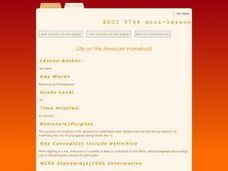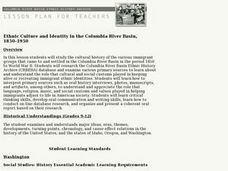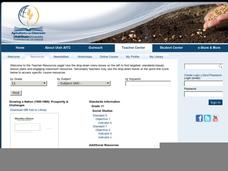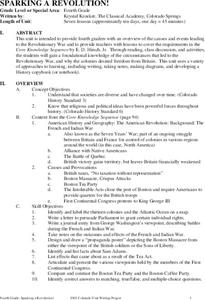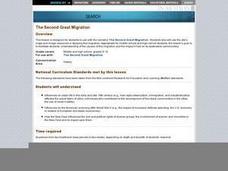Curated OER
Life on the American Homefront
Seventh graders examine the conditions of the homefront during World War II. Using propaganda, they discuss its role and how it affected people who viewed it. They identify the role citizens played during the war and create their own...
Curated OER
Ethnic Culture and Identity in the Columbia River Basin, 1850-1950
Students explore cultural history of immigrant groups that settled in the Columbia River Basin from 1850 to World War II, and examine various primary sources to explore role cultural and social customs played in keeping alive immigrant...
Curated OER
Scapegoating
Students examine how stereotypes, prejudices and discriminatory practices lead to individuals and groups being blamed for events. They are introduced to the internment of Japanese Americans during World War II.
Curated OER
Korean War
Students visualize where the Korean Peninsula is located and what are some neighboring countries. They read a handout giving background information on Korea's 20th centuy history and Truman's Statement and answer questions in their...
Agriculture in the Classroom
Growing a Nation (1950-1969): Prosperity & Challenges: The Story of American Agriculture
A wonderful lesson on the development and impact of mechanized farming! History or agriculture classes learn the historical background of the United States' food production by creating a pamphlet with information on the cause and effect...
Curated OER
The Great Depression: 1930s through WWII
Here is an oddly formated presentation that does have some great information and neat ideas. It includes images and text describing the causes and effects of the Great Depression, FDR, Herbert Hoover, and Eleanor Roosevelt. It also...
Smithsonian Institution
Cuban Missile Crisis
The United States—specifically John F. Kennedy—played a large role during the Cuban Missile Crisis. A history resource poses questions that encourage critical thinking as well as in-depth analysis of images from the time period.
Curated OER
Celebrate The Four Seasons
Students investigate cause and effect and compare and contrast how recurring cycles are evident in multiple aspects of their education. They answer questions in the chosen field. Students model each aspect by interpreting, perceiving and...
Curated OER
The Atomic Bomb
In this atomic bomb study guide worksheet, students read a brief overview pertaining to the topic and then respond to a reflection question.
Curated OER
Fractions: Jewish Population of Europe during WWII
Students evaluate population maps and convert fractions to percentages. In this WWII lesson, students use statistics on the Holocaust to determine population loss and change. Students create their own math questions and answers using the...
Curated OER
The Arms Race - From the Beginning to the End
Ninth graders focus on the political and technological developments of the Cold War. They, in groups, read and summarize the speech they are given. They should provide a short presentation based on their interpretation.
Curated OER
Saudi Arabia
Students view a video clip about bombings in Saudi Arabia. They discuss the causes and implications of other recent terrorist attacks. They examine the United States - Saudi Arabia relationship as well.
Curated OER
Sparking a Revolution!
Students investigate the causes and events that lead to the US Revolutionary War. They use a number of study techniques in this unit to discuss why the colonies wanted freedom from Britain.
Curated OER
President John Kennedy
For this President John Kennedy worksheet, learners read a 2 page article and then circle 8 multiple choice answers to 8 questions or facts referring back to the article on President John Kennedy.
Curated OER
Imperialism and Expansion: Part 1
Students explore the era of imperialism and expansion of the United States. In this American history lesson, students play a game regarding the U.S. attempts to expand the nation in the late 1800s and early 1900s.
Curated OER
The Great Depression
Students analyze the causes of the Great Depression. In this Great Depression lesson, students listen to their instructor present lectures regarding the Dust Bowl, stock market crash, and Smoot-Hawley Tariff Act. Students conduct further...
Curated OER
Follow Your Dreams: Career Goals
It is so important for impending high school graduates to start thinking about their potential careers. Here, they discuss the persistence of Blondie Hasler and his impressive transatlantic trip. They follow various routes on a map and...
Curated OER
WWII and the Atomic Bomb
Students explore three decisions about the atomic bomb faced by the U.S. during WWII, take a position on each of the decisions, and defend their position. Should a bomb have been built, dropped, and was the right decision made?
Curated OER
The Crusades
Students investigate the series of religious wars known as the Crusades. In this Crusades lesson, students research Christian and Muslim beliefs and create posters that compare the two. Students discuss the causes of the wars as well as...
Curated OER
Japan's Place In The World
Students conduct research into the history of th Japanese rise to economic power. They use a variety of sources for information and engage in a variety of in class and out of class activities.
Curated OER
U.S. History: The Second Great Migration
Students examine the migration of rural African Americans to northern cities following World War !!. After predicting the effects of cultural and economic factors, they write essays explaining the impact of migration on communities and...
Curated OER
Reconstruction
Students explain how the Civil War and Reconstruction both solved and created problems for our nation. They study how Reconstruction caused a further decline in relations between the North & South and how racism has been and is...
Curated OER
Immigration and Migration: Today and During the Great Depression
Students conduct interviews, analyze primary sources including docuements and images to gain an inderstanding of the causes and effects of he Great Depression and immigration.
Curated OER
Numbers Tell a Story
Learners connect census data to historical events. In this civics lesson plan, students understand cause and effect, and how they are reflected in census data and analyze census data for social and economic significance.


